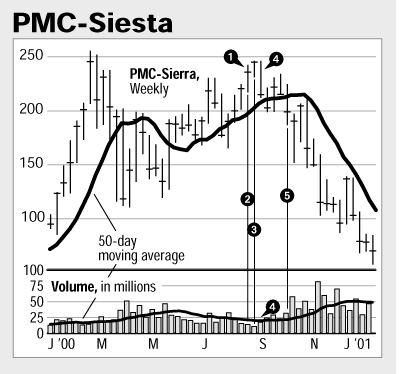
INVESTOR'S BUSINESS DAILY
When a stock blasts out of a base, you want to see volume surge. What happens if the volume isn't there? The stock could fall flat.
The success of a stock's breakout doesn't rely solely on volume. But if demand is lacking, this could be a sign to steer clear. The stock might not have what it takes to launch into a big price move.
Think of volume as the window into supply and demand. It reflects whether institutions are trading heavily or quietly watching from the sidelines. Because institutions make up nearly 75% of total trade, you want them to join the party.
If a stock breaks out of a base and volume is well above its 50-day average, you know that demand for the stock is strong. Trade should rise at least 40% more than its daily average. Among small caps, many bust ahead on at least double or triple normal trade.
But if the breakout comes on low volume, it usually means demand is weak. A stock then might take a big tumble. Whether you've held shares for years or just bought in, such action usually means it's time to sell.
PMC-Sierra was a huge winner in the 1998-2000 bull market. The telecom chip firm cleared a nine-week base on Nov. 9, 1999, and gained 417% to its March 2000 peak.
It corrected 57%, then built a five-month base. When it broke out on Aug. 23 (see point 1 in accompanying image), it seemed to have it all. It held a 96 Earnings Per Share Rating, a 97 for Relative Price Strength and an A for Sales+Profit Margins+ROE. In the latest two quarters, earnings growth had reached 200%. In the past six quarters, sales growth had picked up from 43% to 125%.

PMC-Sierra's Accumulation/Distribution Rating was a B, with 368 mutual funds holding 51 million shares. But solid ratings weren't enough to boost the stock higher.
On its breakout, a daily chart showed volume exceeded the previous day. But trade came in bearishly light vs. its 50-day average. On a weekly chart, volume fell from the prior week, a bad sign (point 2).
In prior breakouts, volume surged. Trade spiked three times its average when the stock broke out of a nine-week base in April 1999. When it leapt out of a longer base to new highs in November 1998, volume soared again.
But this time, the stock displayed reasons to sell. After breaking out on Aug. 23, PMC-Sierra scored paltry gains as volume dried up for eight straight days (point 3). Trade didn't pick up until Sept. 6 when the stock slid 7% (point 4), just the opposite of what you'd like to see.
The stock failed to reach a new high. Then it fell below its pivot of 230.50 and crashed through its 50-day moving average on Oct. 3, another bad sign (point 5). It has since slid 87% below its high.
On April 19 this year, PMC-Sierra reported an 88% drop in first-quarter earnings, breaking its string of six quarters of strong growth. The stock's chart warned investors of problems more than six months earlier.